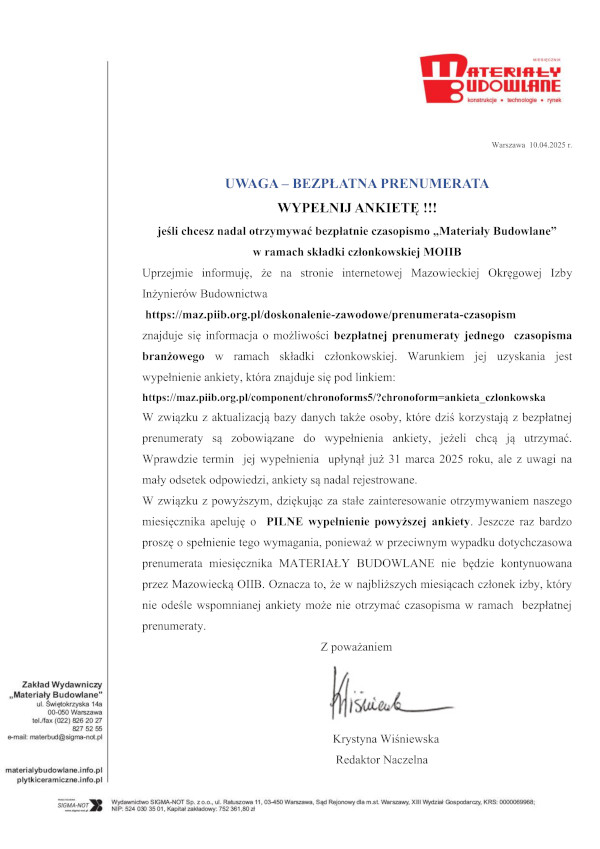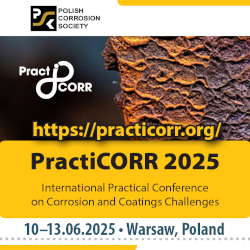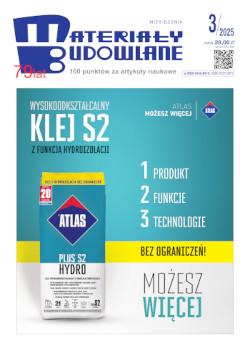dr hab. inż. Paweł Łukowski, prof. Politechnika Warszawska, Wydział Inżynierii Lądowej
Autor do korespondencji e-mail : Ten adres pocztowy jest chroniony przed spamowaniem. Aby go zobaczyć, konieczne jest włączenie w przeglądarce obsługi JavaScript.
DOI: 10.15199/33.2016.10.05
Artykuł dotyczy zagadnienia kompatybilności domieszek do betonu z cementem, a także różnych domieszek między sobą, które jest jednym ze szczególnie istotnych problemów współczesnej technologii betonu. Przedstawiono możliwe przyczyny i skutki braku kompatybilności, ilustrując je odpowiednimi przykładami. Zwrócono uwagę na konieczność prowadzenia dalszych intensywnych prac badawczych w tym obszarze.
Słowa kluczowe: beton, cement, domieszki, kompatybilność.
* * *
Admixtures for concrete – problem of compatibility
The paper deals with the problem of compatibility between admixtures for concrete and cement as well as between various types of modifiers. This is one of the particularly important issues in the contemporary concrete technology. The possible reasons and effects of incompatibility were presented, together with selected examples. Attention was paid to the need of further intensive research works in the discussed area.
Keywords: admixtures, cement, compatibility concrete.
Literatura
[1] ACI 201.2R-08. 2008. Guide to durable concrete. American Concrete Institute, Farmington Hills, USA
[2] Barfield M., N. Ghafoori. 2012. „Air-entrained self-consolidating concrete: A study of admixture sources”. Construction and Building Materials 26: 490 – 496.
[3] Czarnecki Lech, Andrzej Garbacz, Paweł Łukowski, J. R. Clifton. 1999. „Polymer composites for repairing of portland cement concrete: compatibility project”. NIST Report (NISTIR 6394), United States Department of Commerce, National Institute of Standards and Technology, Gaithersburg, USA.
[4] Erdogˇdu S. 2000. „Compatibility of superplasticizers with cements different in composition”. Cement and Concrete Research 30: 767 – 773.
[5] Fagerlund G. 1997. Trwałość konstrukcji betonowych. Warszawa. Arkady.
[6] Gołaszewski Jacek. 2003. Kompatybilność cementu i superplastyfikatora w obecności dodatków mineralnych i domieszki napowietrzającej. V SympozjumNaukowo-Techniczne „ReologiawTechnologiiBetonu”, Gliwice, 89 – 100.
[7] Gołaszewski Jacek. 2012. „Influence of cement properties on new generation superplasticizers performance”. Construction and Building Materials 35: 586 – 596.
[8] Hanehara S., K. Yamada. 1999. „Interaction between cement and chemical admixture fromthe point of cement hydration, absorption behaviour of admixture, and paste rheology”. Cement and Concrete Research 29: 1159 – 1165.
[9] Kato H., K. Yoshioka, H. Ushiyama. 1997. „Influence of sulfate ion on steric hindrance in the performance of superplasticizers”. Japan Cement Association Proceedings of Cement and Concrete 51: 264 – 269.
[10] Łukowski Paweł. 2015. „Rola domieszek we współczesnej technologii betonu”. Materiały Budowlane 10: 106 – 108.
[11] Łukowski Paweł. 2016. Modyfikacja materiałowa betonu. Kraków. Stowarzyszenie Producentów Cementu – Polski Cement.
[12] Mora-Ruacho J., R. Gettu, A. Aguado. 2009. „Influence of shrinkage-reducing admixtures on the reduction of plastic shrinkage cracking in concrete”. Cement and Concrete Research 39: 141 – 146.
[13] Oliveira M., A. Ribeiro, F. Branco. 2014. „Combined effect of expansive and shrinkage reducing admixtures to control autogenous shrinkage in self-compacting concrete”. Construction and BuildingMaterials 52: 267 – 275
[14] Uchikawa H., S. Uchida, K. Ogawa, S. Hanehara. 1984. „Influence of CaSO4×2H2O, CaSO4×½ H2O, and CaSO4 on the initial hydration of clinker with different burning temperatures”. Cement and Concrete Research 14: 645 – 656.
[15] Uchikawa H., S. Hanehara, T. Shirasaka, D. Sawaki. 1992. „Effect of admixture on hydration of cement, adsorptive behavior of admixture, and fluidity and setting of fresh cement paste”. Cement and Concrete Research 22: 1115 – 1129.
Otrzymano : 13.06.2016 r.
Materiały Budowlane 10/2016, str. 14-16 (spis treści >>)






























